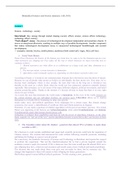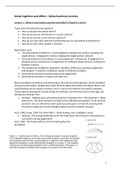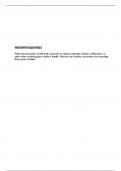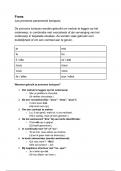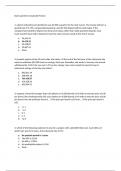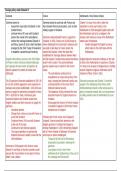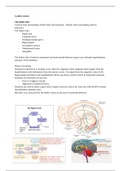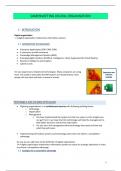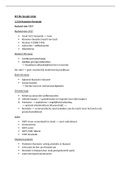Real estate
Week 1 Introduction
What is real estate?
- All goods attached to the earth’s surface (land, land + buildings) = onroerend goed
- Property (UK)
- Physical versus institutional conception
Real estate as a special good
- Immobility -> consequents; every plot or buildings has its own features, locational
(dis)advantages; Heterogeneity
- Longevity -> long term of existence
Market consequences for these features:
1. Emergence of (asset) market
- Immobility -> scarcity -> value development: appreciation
- Longevity -> long-term value
= asset with income-generating potential
2. Thin market
- Few transactions -> few references/not transparent; prijzen vergelijken kan maar
met een klein aantal andere huizen/kantoren vanwege de heterogeniteit
- Importance of valuations -> een expert inhuren om te weten wat de juiste
marktprijzen zijn
- Human factor (mensen maken fouten of willen benefit maken uit je aankoop)
- miscalculations and opportunism
3. Inelastic supply (supply does not respond to changes in price)
- Non-reproducable -> je kan niet een Jaren 30 huis maken in vinexwijk met dezelfde
waarde
- Time and cost of production/removal -> you cannot react instantly
-> Cyclical nature of real estate market (overschot market of tekort in market)
What is commercial real estate? (definitions)
1. Real estate with profit-seeking uses/users
2. Income-generating real estate; separation in ownership & occupation
-> Does not include:
- Owner-occupied housing
- Social/public propery
What are commercial real estate markets? (Defenition Geltner et al. )
“A market is mechanism through which goods and services are voluntarily exchanged
among different owners”
,Markets can be geographically segmented -> regionalized;
- Locational (dis)advantages
- Daily urban systems
Markets can be functional segmented
- Different uses/users
- Land-use planning (zoning)
3 different markets; space (usage), asset (investment market), construction (development
market)
4Q model of real estate market
- Equilibrium
- Market clearing
- Balancing/negative feedback loops
P = R/Y
VB: The stock cannot react instantly on the demand, so it will stay the same if the demand
increases -> the prices go up, so construction go up and the stock will increase in the long
run; the new stock will lower the price
, Feedback loops
Negative feedback loop = a balancing feedback loop; if it goes up at one point, it shifts again
and go down; to balance
Vb: classical economics; equilibrium
Vb: too much supply in space market will make future rents lower, which will cause a
reduction in property market values today. Development industry will then be cut off.
Eventually the long-run equilibrium level will be reached. If participants are sufficiently
looking forward, the negative feedback loop can keep supply and demand in pretty good
balance.
Positive feedback loop = investors lose sight of risks -> a reinforcing feedback loop; if it goes
up, it goes up further; so, it will spin out of control and not brought back to balance
vb: pandamic
Vb: house price increase but construction costs increase as well -> construction stops
because of the high prices and then the high demand will increase the prices even more)
Cap rate? Is determined by supply and demand, based on three factors:
1. Opportunity costs of capital; the interest rates and opportunities for earning
returns in other forms of investments in the capital markets (stock, bonds) are a
major determinant of how much investors are willing to pay. Real estate assets
are competing not only with other properties, but also with other forms of assets.
2. Growth expectations; potential investors will be forward looking, considering the
likely amount of growth or decline in the net rent. Unique attributes of a property
will also define growth.
3. Risk; if investors regard the future potential net income as less risky, they will be
willing to pay more per dollar of current income for the property, also reducing
the cap rate.
Institutional economic critique
- Rationality -> Bounded Rationality; people do not act perfectly rational
- Perfect information -> Imperfect/asymmetric information; people know different things;
the owner knows more of the property than the buyer
- Self-interested -> self-interested ‘with guile’ (= opportunism)
- Frictionless market -> transaction costs; in reality there are transaction costs involved
- Unconstrained behavior -> importance of institutions; constraints by many institutions
What are institutions? (definitions)
“The rules of the game that guide human interaction”
“Systems of established and prevalent social rules that structure social interactions”
Rules made for and by social interaction
Week 1 Introduction
What is real estate?
- All goods attached to the earth’s surface (land, land + buildings) = onroerend goed
- Property (UK)
- Physical versus institutional conception
Real estate as a special good
- Immobility -> consequents; every plot or buildings has its own features, locational
(dis)advantages; Heterogeneity
- Longevity -> long term of existence
Market consequences for these features:
1. Emergence of (asset) market
- Immobility -> scarcity -> value development: appreciation
- Longevity -> long-term value
= asset with income-generating potential
2. Thin market
- Few transactions -> few references/not transparent; prijzen vergelijken kan maar
met een klein aantal andere huizen/kantoren vanwege de heterogeniteit
- Importance of valuations -> een expert inhuren om te weten wat de juiste
marktprijzen zijn
- Human factor (mensen maken fouten of willen benefit maken uit je aankoop)
- miscalculations and opportunism
3. Inelastic supply (supply does not respond to changes in price)
- Non-reproducable -> je kan niet een Jaren 30 huis maken in vinexwijk met dezelfde
waarde
- Time and cost of production/removal -> you cannot react instantly
-> Cyclical nature of real estate market (overschot market of tekort in market)
What is commercial real estate? (definitions)
1. Real estate with profit-seeking uses/users
2. Income-generating real estate; separation in ownership & occupation
-> Does not include:
- Owner-occupied housing
- Social/public propery
What are commercial real estate markets? (Defenition Geltner et al. )
“A market is mechanism through which goods and services are voluntarily exchanged
among different owners”
,Markets can be geographically segmented -> regionalized;
- Locational (dis)advantages
- Daily urban systems
Markets can be functional segmented
- Different uses/users
- Land-use planning (zoning)
3 different markets; space (usage), asset (investment market), construction (development
market)
4Q model of real estate market
- Equilibrium
- Market clearing
- Balancing/negative feedback loops
P = R/Y
VB: The stock cannot react instantly on the demand, so it will stay the same if the demand
increases -> the prices go up, so construction go up and the stock will increase in the long
run; the new stock will lower the price
, Feedback loops
Negative feedback loop = a balancing feedback loop; if it goes up at one point, it shifts again
and go down; to balance
Vb: classical economics; equilibrium
Vb: too much supply in space market will make future rents lower, which will cause a
reduction in property market values today. Development industry will then be cut off.
Eventually the long-run equilibrium level will be reached. If participants are sufficiently
looking forward, the negative feedback loop can keep supply and demand in pretty good
balance.
Positive feedback loop = investors lose sight of risks -> a reinforcing feedback loop; if it goes
up, it goes up further; so, it will spin out of control and not brought back to balance
vb: pandamic
Vb: house price increase but construction costs increase as well -> construction stops
because of the high prices and then the high demand will increase the prices even more)
Cap rate? Is determined by supply and demand, based on three factors:
1. Opportunity costs of capital; the interest rates and opportunities for earning
returns in other forms of investments in the capital markets (stock, bonds) are a
major determinant of how much investors are willing to pay. Real estate assets
are competing not only with other properties, but also with other forms of assets.
2. Growth expectations; potential investors will be forward looking, considering the
likely amount of growth or decline in the net rent. Unique attributes of a property
will also define growth.
3. Risk; if investors regard the future potential net income as less risky, they will be
willing to pay more per dollar of current income for the property, also reducing
the cap rate.
Institutional economic critique
- Rationality -> Bounded Rationality; people do not act perfectly rational
- Perfect information -> Imperfect/asymmetric information; people know different things;
the owner knows more of the property than the buyer
- Self-interested -> self-interested ‘with guile’ (= opportunism)
- Frictionless market -> transaction costs; in reality there are transaction costs involved
- Unconstrained behavior -> importance of institutions; constraints by many institutions
What are institutions? (definitions)
“The rules of the game that guide human interaction”
“Systems of established and prevalent social rules that structure social interactions”
Rules made for and by social interaction

